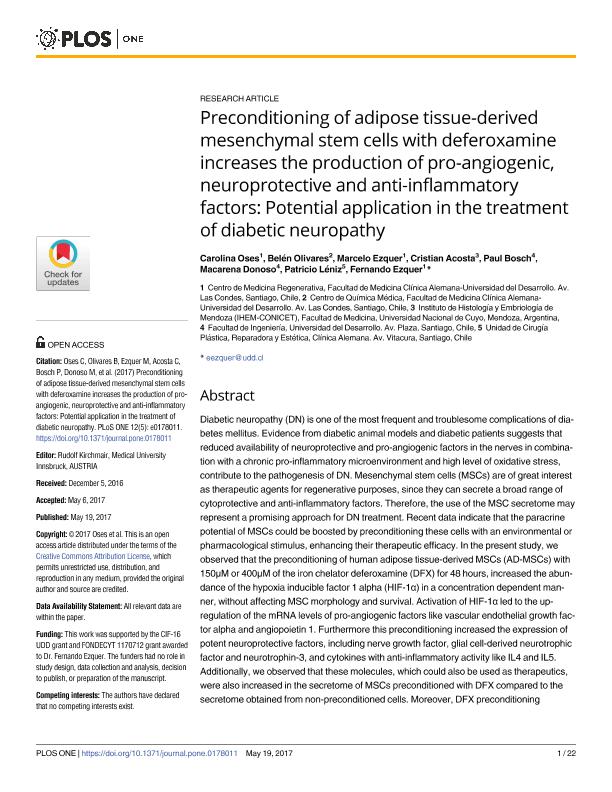Mostrar el registro sencillo del ítem
dc.contributor.author
Oses, Carolina
dc.contributor.author
Olivares, Belén
dc.contributor.author
Ezquer, Eduardo Marcelo

dc.contributor.author
Acosta, Cristian Gabriel

dc.contributor.author
Bosch, Paul
dc.contributor.author
Donoso, Macarena
dc.contributor.author
Léniz, Patricio
dc.contributor.author
Ezquer, Fernando
dc.date.available
2018-06-19T19:15:22Z
dc.date.issued
2017-05
dc.identifier.citation
Oses, Carolina; Olivares, Belén; Ezquer, Eduardo Marcelo; Acosta, Cristian Gabriel; Bosch, Paul; et al.; Preconditioning of adipose tissue-derived mesenchymal stem cells with deferoxamine increases the production of pro-angiogenic, neuroprotective and anti-inflammatory factors: Potential application in the treatment of diabetic neuropathy; Public Library of Science; Plos One; 12; 5; 5-2017; 1-22
dc.identifier.issn
1932-6203
dc.identifier.uri
http://hdl.handle.net/11336/49396
dc.description.abstract
Diabetic neuropathy (DN) is one of the most frequent and troublesome complications of diabetes mellitus. Evidence from diabetic animal models and diabetic patients suggests that reduced availability of neuroprotective and pro-angiogenic factors in the nerves in combination with a chronic pro-inflammatory microenvironment and high level of oxidative stress, contribute to the pathogenesis of DN. Mesenchymal stem cells (MSCs) are of great interest as therapeutic agents for regenerative purposes, since they can secrete a broad range of cytoprotective and anti-inflammatory factors. Therefore, the use of the MSC secretome may represent a promising approach for DN treatment. Recent data indicate that the paracrine potential of MSCs could be boosted by preconditioning these cells with an environmental or pharmacological stimulus, enhancing their therapeutic efficacy. In the present study, we observed that the preconditioning of human adipose tissue-derived MSCs (AD-MSCs) with 150μM or 400μM of the iron chelator deferoxamine (DFX) for 48 hours, increased the abundance of the hypoxia inducible factor 1 alpha (HIF-1 a) in a concentration dependent manner, without affecting MSC morphology and survival. Activation of HIF-1 a led to the up-regulation of the mRNA levels of pro-angiogenic factors like vascular endothelial growth factor alpha and angiopoietin 1. Furthermore this preconditioning increased the expression of potent neuroprotective factors, including nerve growth factor, glial cell-derived neurotrophic factor and neurotrophin-3, and cytokines with anti-inflammatory activity like IL4 and IL5. Additionally, we observed that these molecules, which could also be used as therapeutics, were also increased in the secretome of MSCs preconditioned with DFX compared to the secretome obtained from non-preconditioned cells. Moreover, DFX preconditioning significantly increased the total antioxidant capacity of the MSC secretome and they showed neuroprotective effects when evaluated in an in vitro model of DN. Altogether, our findings suggest that DFX preconditioning of AD-MSCs improves their therapeutic potential and should be considered as a potential strategy for the generation of new alternatives for DN treatment.
dc.format
application/pdf
dc.language.iso
eng
dc.publisher
Public Library of Science

dc.rights
info:eu-repo/semantics/openAccess
dc.rights.uri
https://creativecommons.org/licenses/by-nc-sa/2.5/ar/
dc.subject
Mesenchymal Stem Cells
dc.subject
Sensory Neurons
dc.subject
Diabetic Neuropathy
dc.subject
Neuronal Death
dc.subject.classification
Otras Ciencias Biológicas

dc.subject.classification
Ciencias Biológicas

dc.subject.classification
CIENCIAS NATURALES Y EXACTAS

dc.subject.classification
Otras Biotecnologías de la Salud

dc.subject.classification
Biotecnología de la Salud

dc.subject.classification
CIENCIAS MÉDICAS Y DE LA SALUD

dc.title
Preconditioning of adipose tissue-derived mesenchymal stem cells with deferoxamine increases the production of pro-angiogenic, neuroprotective and anti-inflammatory factors: Potential application in the treatment of diabetic neuropathy
dc.type
info:eu-repo/semantics/article
dc.type
info:ar-repo/semantics/artículo
dc.type
info:eu-repo/semantics/publishedVersion
dc.date.updated
2018-06-13T16:54:14Z
dc.journal.volume
12
dc.journal.number
5
dc.journal.pagination
1-22
dc.journal.pais
Estados Unidos

dc.journal.ciudad
San Francisco
dc.description.fil
Fil: Oses, Carolina. Universidad del Desarrollo; Chile
dc.description.fil
Fil: Olivares, Belén. Universidad del Desarrollo; Chile
dc.description.fil
Fil: Ezquer, Eduardo Marcelo. Universidad del Desarrollo; Chile
dc.description.fil
Fil: Acosta, Cristian Gabriel. Consejo Nacional de Investigaciones Científicas y Técnicas. Centro Científico Tecnológico Conicet - Mendoza. Instituto de Histología y Embriología de Mendoza Dr. Mario H. Burgos. Universidad Nacional de Cuyo. Facultad de Cienicas Médicas. Instituto de Histología y Embriología de Mendoza Dr. Mario H. Burgos; Argentina
dc.description.fil
Fil: Bosch, Paul. Universidad del Desarrollo; Chile
dc.description.fil
Fil: Donoso, Macarena. Universidad del Desarrollo; Chile
dc.description.fil
Fil: Léniz, Patricio. Clinica Alemana; Chile
dc.description.fil
Fil: Ezquer, Fernando. Universidad del Desarrollo; Chile
dc.journal.title
Plos One

dc.relation.alternativeid
info:eu-repo/semantics/altIdentifier/doi/http://dx.doi.org/10.1371/journal.pone.0178011
dc.relation.alternativeid
info:eu-repo/semantics/altIdentifier/url/http://journals.plos.org/plosone/article?id=10.1371/journal.pone.0178011
Archivos asociados
